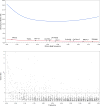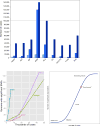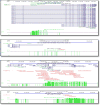Psychiatric Genomics: An Update and an Agenda
- PMID: 28969442
- PMCID: PMC5756100
- DOI: 10.1176/appi.ajp.2017.17030283
Psychiatric Genomics: An Update and an Agenda
Abstract
The Psychiatric Genomics Consortium (PGC) is the largest consortium in the history of psychiatry. This global effort is dedicated to rapid progress and open science, and in the past decade it has delivered an increasing flow of new knowledge about the fundamental basis of common psychiatric disorders. The PGC has recently commenced a program of research designed to deliver "actionable" findings-genomic results that 1) reveal fundamental biology, 2) inform clinical practice, and 3) deliver new therapeutic targets. The central idea of the PGC is to convert the family history risk factor into biologically, clinically, and therapeutically meaningful insights. The emerging findings suggest that we are entering a phase of accelerated genetic discovery for multiple psychiatric disorders. These findings are likely to elucidate the genetic portions of these truly complex traits, and this knowledge can then be mined for its relevance for improved therapeutics and its impact on psychiatric practice within a precision medicine framework. [AJP at 175: Remembering Our Past As We Envision Our Future November 1946: The Genetic Theory of Schizophrenia Franz Kallmann's influential twin study of schizophrenia in 691 twin pairs was the largest in the field for nearly four decades. (Am J Psychiatry 1946; 103:309-322 )].
Keywords: Biological Markers; Genetics.
Figures

 ) shows minimum detectable genotypic relative risks for common variants for 1,000 cases and 1,000 controls (90% power, additive model, lifetime risk 0.01, α=5e-8). Lower curve (
) shows minimum detectable genotypic relative risks for common variants for 1,000 cases and 1,000 controls (90% power, additive model, lifetime risk 0.01, α=5e-8). Lower curve (
 ) shows 90% power for the PGC 2014 schizophrenia paper (37,000 cases and 113,000 controls, additive model, lifetime morbid risk 0.01, α=5×10− 8). Black dots show the top 10 loci in the PGC schizophrenia report. These loci are highly significant with P-values ranging from 1.7×10−13 to 3.8×10−32. b. Odds ratios (OR, log10 scale) and allele frequencies from published GWAS. From EBI-NHGRI GWAS catalog (accessed 1/27/2017), contains 2,308 GWAS papers published 3/2005–7/2016. There are 9,485 SNP-trait associations (P ≤ 1×1−8) including 7,487 SNPS and 870 traits. Dots show frequency and OR (transformed to be >1 and allele frequencies to 0–0.50). Contours show densest areas of the plot. Horizontal lines show 50th (OR=1.22) and 90th (OR=1.95) percentiles for ORs: most associations are subtle. Of 62 associations with OR>5, most are for infectious disease (N=31; e.g., influenza susceptibility), pharmacogenomic (N=13; e.g., rare adverse drug reactions like flucloxacillin-induced liver injury), eye disease (N=4; e.g., glaucoma), or pigmentation (N=2; e.g., blue vs. brown eyes). Only a few diseases have atypically large ORs (e.g., celiac disease, melanoma, membranous nephropathy, myasthenia gravis, ovarian cancer, Parkinson's disease, progressive supranuclear palsy, thyrotoxic hypokalemic periodic paralysis, and type 1 diabetes). The only psychiatric finding was alcohol consumption and ALDH2 in individuals of East Asian ancestry.
) shows 90% power for the PGC 2014 schizophrenia paper (37,000 cases and 113,000 controls, additive model, lifetime morbid risk 0.01, α=5×10− 8). Black dots show the top 10 loci in the PGC schizophrenia report. These loci are highly significant with P-values ranging from 1.7×10−13 to 3.8×10−32. b. Odds ratios (OR, log10 scale) and allele frequencies from published GWAS. From EBI-NHGRI GWAS catalog (accessed 1/27/2017), contains 2,308 GWAS papers published 3/2005–7/2016. There are 9,485 SNP-trait associations (P ≤ 1×1−8) including 7,487 SNPS and 870 traits. Dots show frequency and OR (transformed to be >1 and allele frequencies to 0–0.50). Contours show densest areas of the plot. Horizontal lines show 50th (OR=1.22) and 90th (OR=1.95) percentiles for ORs: most associations are subtle. Of 62 associations with OR>5, most are for infectious disease (N=31; e.g., influenza susceptibility), pharmacogenomic (N=13; e.g., rare adverse drug reactions like flucloxacillin-induced liver injury), eye disease (N=4; e.g., glaucoma), or pigmentation (N=2; e.g., blue vs. brown eyes). Only a few diseases have atypically large ORs (e.g., celiac disease, melanoma, membranous nephropathy, myasthenia gravis, ovarian cancer, Parkinson's disease, progressive supranuclear palsy, thyrotoxic hypokalemic periodic paralysis, and type 1 diabetes). The only psychiatric finding was alcohol consumption and ALDH2 in individuals of East Asian ancestry.
 ) shows common-variant associations for schizophrenia (P<1e-8) (19). Open diamonds (
) shows common-variant associations for schizophrenia (P<1e-8) (19). Open diamonds (
 ) show copy number variation associated with schizophrenia (34). Filled square (
) show copy number variation associated with schizophrenia (34). Filled square (
 ) shows the lone variant identified using whole exome sequencing (35).
) shows the lone variant identified using whole exome sequencing (35).

Comment in
-
AJP at 175: Remembering Our Past as We Envision Our Future.Am J Psychiatry. 2018 Jan 1;175(1):1. doi: 10.1176/appi.ajp.2017.17101137. Am J Psychiatry. 2018. PMID: 29301421 No abstract available.
References
-
- Kendler KS, Prescott CA. Genes, Environment, and Psychopathology. New York: Guilford Press; 2006.
-
- Polderman TJ, Benyamin B, de Leeuw CA, Sullivan PF, van Bochoven A, Visscher PM, Posthuma D. Fifty years of twin studies: A meta-analysis of the heritability of human traits. Nature Genetics. 2015;47:702–709. - PubMed
-
- Kallmann FJ. The genetic theory of schizophrenia: and analysis of 691 schizophrenic twin index families. Am J Psychiatry. 1946;103:309–322. - PubMed
-
- Sullivan PF, Kendler KS, Neale MC. Schizophrenia as a complex trait: evidence from a meta-analysis of twin studies. Arch Gen Psychiatry. 2003;60:1187–1192. - PubMed
Publication types
MeSH terms
Substances
Grants and funding
LinkOut - more resources
Full Text Sources
Other Literature Sources
Medical
Research Materials
Miscellaneous

